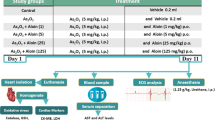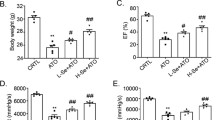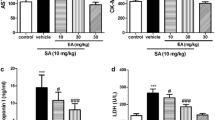Abstract
Arsenic, one of the most harmful metalloids, is ubiquitous in the environment. The present study has been carried out to investigate the protective role of a triterpenoid saponin, arjunolic acid (AA) against arsenic-induced cardiac oxidative damage. In the study, NaAsO2 was chosen as the source of arsenic. The free radical scavenging activity and the effect of AA on the intracellular antioxidant power were determined from its 2,2-diphenyl-1-picryl hydrazyl radical scavenging ability and ferric reducing/antioxidant power assay, respectively. Oral administration of NaAsO2 at a dose of 10 mg/kg body weight for 2 days caused significant accumulation of arsenic in cardiac tissues of the experimental mice in association with the reduction in cardiac antioxidant enzymes activities, namely superoxide dismutase, catalase, glutathione-S-transferase, glutathione reductase and glutathione peroxidase. Arsenic intoxication also decreased the cardiac glutathione (GSH) and total thiol contents and increased the levels of oxidized glutathione (GSSG), lipid peroxidation end products and protein carbonyl content. Treatment with AA at a dose of 20 mg/kg body weight for 4 days prior to NaAsO2 intoxication protected the cardiac tissue from arsenic-induced oxidative impairment. In addition to oxidative stress, arsenic administration increased total cholesterol level as well as the reduced high-density lipoprotein cholesterol level in the sera of the experimental mice. AA pretreatment, however, could prevent this hyperlipidemia. Histological studies on the ultrastructural changes in cardiac tissue supported the protective activity of AA also. Combining all, results suggest that AA could protect cardiac tissues against arsenic-induced oxidative stress probably due to its antioxidant property.





Similar content being viewed by others
Abbreviations
- AA:
-
Arjunolic acid
- CAT:
-
catalase
- CDNB:
-
1-Chloro-2,4-dinitrobenzene
- DNPH:
-
2,4-Dinitro phenyl hydrazine
- DTNB:
-
5,5′-Dithiobis(2-nitrobenzoic acid) (Ellman’s reagent)
- EDTA:
-
Ethylene diamine tetraacetic acid
- NEM:
-
N-ethylmaleimide
- FeCl3 :
-
Ferric chloride
- FRAP:
-
Ferric reducing/antioxidant power
- GPx:
-
Glutathione peroxidase
- GR:
-
Glutathione reductase
- GST:
-
Glutathione-S-transferase
- HDL:
-
High-density lipoprotein
- H2O2 :
-
Hydrogen peroxide
- IR:
-
Infrared-spectroscopy
- MDA:
-
Malondialdehyde
- NADH:
-
Nicotinamide adenine dinucleotide reduced
- NBT:
-
Nitro blue tetrazolium
- NMR:
-
Nuclear magnetic resonance
- GSSG:
-
Oxidized glutathione
- KH2PO4 :
-
Potassium dihydrogen phosphate
- PMT:
-
Phenazine methosulphate
- ROS:
-
Reactive oxygen species
- GSH:
-
Reduced glutathione
- NaAsO2 :
-
Sodium arsenite
- NaN3 :
-
Sodium azide
- TA:
-
Terminalia arjuna
- TCA:
-
Trichloro acetic acid
- TBA:
-
Thiobarbituric acid
- TPTZ:
-
2,4,6-Tripyridyl-1,3,5-triazine
References
Ahmad S, Kitchin KT, Cullen WR (2000) Arsenic species that cause release of iron from ferritin and generation of activated oxygen. Arch Biochem Biophys 382:195–202
Anon. (1999) Altern Med Rev 3:422–431
Bag BG, Pramanik SR, Maity GC (2005) Arjunolic acid in molecular recognition: first synthesis and cation binding studies of a novel Arjuna-18-crown-6. Supramol Chem 17:297–302
Barchowsky A, Klei LR, Dudek EJ, Swartz HM, James PE (1999) Stimulation of reactive oxygen, but not reactive nitrogen species, in vascular endothelial cells exposed to low levels of arsenite. Free Radic Biol Med 27:1405–1412
Bashir S, Sharma Y, Irshad M, Dutta-Gupta S, Dogra TD (2006) Arsenic-induced cell death in liver and brain of experimental rats. Basic Clin Pharmacol Toxicol 98:38–43
Benowitz NL (1992) Cardiotoxicity in the workplace. Occup Med 7:465–478
Benzie IFF, Strain JJ (1999) Ferric reducing/antioxidant power assay: direct measure of total antioxidant activity of biological fluids and modified version for simultaneous measurement of total antioxidant power and ascorbic acid concentration. Methods Enzymol 299:15–27
Bharani A, Ganguly A, Bhargava KD (1995) Salutary effect of Terminalia arjuna in patients with severe refractory heart failure. Int J Cardiol 49:191–199
Blois MS (1958) Antioxidant determination by use of a stable free radical. Nature 29:1199–1200
Bonaventura J, Schroeder WA, Fang S (1972) Human erythrocyte catalase: an improved method of isolation and a revaluation of reported properties. Arch Biochem Biophys 150:606–617
Bradford MM (1976) A rapid and sensitive method for the quantitation of microgram quantities of protein utilizing the principle of protein-dye binding. Anal Biochem 72:248–254
Corsini E, Asti L, Viviani B, Marinovich M, Galli CL (1999) Sodium arsenate induces overproduction of interleukin-1alpha in murine keratinocytes: role of mitochondria. J Invest Dermatol 113:760–765
Das D, Chatterjee A, Mandal BK, Samanta G, Chakraborti D (1995) Arsenic in groundwater in six districts of West Bengal, India, The biggest arsenic calamity in the world. Part II Arsenic concentration in drinking water hair, nails, urine, skin-scale and liver tissue (biopsy) of the affected people. Analyst 120:917–924
Del Razo LM, Quintanilla-Vega B, Brambila-Colombres E, Calderon-Aranda ES, Manno M, Albores A (2001) Stress proteins induced by arsenic. Toxicol Appl Pharmacol 177:132–148
Delnomdedieu M, Basti MM, Otvos JD, Thomas DJ (1993) Transfer of arsenite from glutathione to dithiols: a model of interaction. Chem Res Toxicol 6:598–602
Dhalla NS, Temsah RM, Netticadan T (2000) Role of oxidative stress in cardiovascular diseases. J Hypertens 18:655–673
Ellman GL (1959) Tissue sulfhydryl group. Arch Biochem Biophys 82:70–77
Esterbauer H, Cheeseman KH (1990) Determination of aldehydic lipid peroxidation products: malonaldehyde and 4-hydroxynonenal. Methods Enzymol 186:407–421
Flohe L, Ginzler WA (1984) Assay of glutathione peroxidase. Methods Enzymol 105:114–121
Fulladosa E, Murat JC, Bollinger JC, Villaescusa I (2007) Adverse effects of organic arsenical compounds towards Vibrio fischeri bacteria. Sci Total Environ 377:207–213
Goldsmith S, From AH (1980) Arsenic-induced atypical ventricular tachycardia. N Engl J Med 303:1096–1098
Habig WH, Pabst MJ, Jakoby WB (1974) Glutathione S-transferases. The first enzymatic step in mercapturic acid formation. J Biol Chem 249:7130–7139
Haidara MA, Yassin HZ, Rateb M, Ammar H, Zorkani MA (2006) Role of oxidative stress in development of cardiovascular complications in diabetes mellitus. Curr Vasc Pharmacol 4:215–227
Hissin PJ, Hilf RA (1976) A fluorometric method for determination of oxidized and reduced glutathione in tissues. Anal Biochem 74:214–226
Hughes MF (2002) Arsenic toxicity and potential mechanisms of action. Toxicol Lett 133:1–16
Jones DP (2002) Redox potential of GSH/GSSG couple: assay and biological significance. Methods Enzymol 348:93–112
Kakkar P, Das B, Viswanathan PN (1984) A modified spectrophotometric assay of superoxide dismutase. Ind J Biochem Biophys 21:30–132
Karthikeyan K, Sarala Bai BR, Gauthaman K, Sathish KS, Niranjali Devaraj S (2003) Cardioprotective effect of the alcoholic extract of Terminalia arjuna bark in an in vivo model of myocardial ischemic reperfusion injury. Life Sci 73:2727–2739
King FE, King TJ, Ross JM (1954) The constitution of arjunolic acid, a triterpene from Terminalia arjuna. J Chem Soc 23:3995–4003
Kirkman MN, Gaetani GF (1984) Catalase: a tetrameric enzyme with four tightly bound molecules of NADPH. Proc Natl Acad Sci USA 81:4343–4347
Kono Y, Fridovich I (1982) Superoxide radical inhibits catalase. J Biol Chem 257:5751–5754
Kulp TR, Hoeft SE, Oremland RS (2004) Redox transformations of arsenic oxyanions in periphyton communities. Appl Environ Microbiol 70:6428–6434
Lee J, Heng D, Chia KS, Chew SK, Tan BY, Hughes K (2001) Risk factors and incident coronary heart disease in Chinese, Malay and Asian Indian males: the Singapore Cardiovascular Cohort Study. Int J Epidemiol 30:983–988
Lin KT, Xue JY, Sun FF, Wong PYK (1997) Reactive oxygen species participate in peroxinitrile induced apoptosis in HL 60 cells. Biochem Biophys Res Commun 230:115–119
Lin S, Cullen WR, Thomas DJ (1999) Methylarsenicals and arsinothiols are potent inhibitors of mouse liver thioredoxin reductase. Chem Res Toxicol 12:924–930
Liu F, Jan KY (2000) DNA damage in arsenite- and cadmium-treated bovine aortic endothelial cells. Free Radic Biol Med 28:55–63
Lynn S, Shiung JN, Gurr JR, Jan KY (1998) Arsenite stimulates poly (ADPribosylation) by generation of nitric oxide. Free Radic Biol Med 24:442–449
Nammi S, Gudavalli R, Babu BS, Lodagala DS, Boini KM (2003) Possible mechanisms of hypotension produced 70% alcoholic extract of Terminalia arjuna (L.) in anaesthetized dogs. BMC Complement Altern Med 16:3–5
Nishikimi M, Rao NA, Yagi K (1972) The occurrence of superoxide anion in the reaction of reduced phenazine methosulfate and molecular oxygen. Biochem Biophys Res Commun 46:849–854
Ratnaike RN (2003) Acute and chronic arsenic toxicity. Postgrad Med J 79:391–396
Scott N, Hatlelid KM, MacKenzie NE, Carter DE (1993) Reactions of arsenic (III) and arsenic (V) species with glutathione. Chem Res Toxicol 6:102–106
Sedlak J, Lindsay RH (1958) Estimation of total, protein-bound, and nonprotein sulfhydryl groups in tissue with Ellman’s reagent. Anal Biochem 24/25:192–205
Shi H, Shi X, Liu KJ (2004) Oxidative mechanism of arsenic toxicity and carcinogenesis. Mol Cell Biochem 255:67–78
Smith IK, Vierheller TL, Thorne CA (1988) Assay of glutathione reductase in crude tissue homogenates using 5,5′-dithiobis (2-nitrobenzoic acid). Anal Biochem 175:408–413
Styblo M, Yamauchi H, Thomas DJ (1995) Comparative in vitro methylation of trivalent and pentavalent arsenicals. Toxicol Appl Pharmacol 135:172–178
Styblo M, Serves SV, Cullen WR, Thomas DJ (1997) Comparative inhibition of yeast glutathione reductase by arsenicals and arsenothiols. Chem Res Toxicol 10:27–33
Sumitra M, Manikandan P, Kumar DA, Arutselvan N, Balakrishna K, Manohar BM, Puvanakrishnan R (2001) Experimental myocardial necrosis in rats: role of arjunolic acid on platelet aggregation, coagulation and antioxidant status. Mol Cell Biochem 224:135–142
Uchida K, Stadtman ER (1993) Covalent attachment of 4-hydroxynonenal to glyceraldehydes-3-phosphate dehydrogenase. J Biol Chem 268:6388–6393
Vahter M (2002) Mechanisms of arsenic biotransformation. Toxicology 181–182:211–217
Wang CH, Hsiao CK, Chen CL, Hsu LI, Chiou HY, Chen SY, Hsueh YM, Wu MM, Chen CJ (2006) A review of the epidemiologic literature on the role of environmental arsenic exposure and cardiovascular diseases. Toxicol Appl Pharmacol 222:315–326
Wang TS, Kuo CF, Jan KY, Huang H (1996) Arsenite induces apoptosis in Chinese hamster ovary cells by generation of reactive oxygen species. J Cell Physiol 169:256–268
Yamanaka K, Okada S (1994) Induction of lung-specific DNA damage by metabolically methylated arsenics via the production of free radicals. Environ Health Perspect 102:37–40
Yamanaka K, Hesegwa A, Sawamuna R, Okada S (1991) Cellular response to oxidative damage in lung induced by the administration of dimethylarsinic acid, a major metabolite of inorganic arsenics, in mice. Toxicol Appl Pharmacol 108:205–213
Yamanaka K, Hayashi H, Tachikawa M, Kato K, Hasegawa A, Oku N, Okada S (1997) Metabolic methylation is a possible genotoxicity-enhancing process of inorganic arsenics. Mutat Res 394:95–101
Yamanaka K, Mizol M, Kato K, Hasegawa A, Nakano M, Okada S (2001) Oral administration of dimethylarsinic acid, a main metabolite of inorganic arsenic, in mice promotes skin tumorigenesis initiated by dimethylbenz(a)anthracene with or without ultraviolet B as a promoter. Biol Pharm Bull 24:510–514
Acknowledgments
The authors are grateful to Mr. Prasanta Pal for his excellent technical assistance during the entire study.
Author information
Authors and Affiliations
Corresponding author
Additional information
P. Manna and M. Sinha contributed equally in this study.
Rights and permissions
About this article
Cite this article
Manna, P., Sinha, M. & Sil, P.C. Arsenic-induced oxidative myocardial injury: protective role of arjunolic acid . Arch Toxicol 82, 137–149 (2008). https://doi.org/10.1007/s00204-007-0272-8
Received:
Accepted:
Published:
Issue Date:
DOI: https://doi.org/10.1007/s00204-007-0272-8




